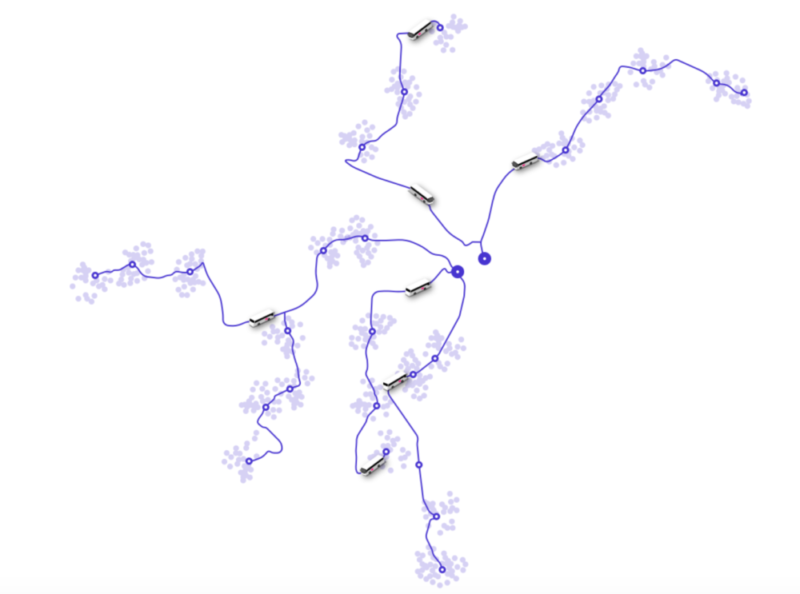
By Nika Strukelj.
Artificial intelligence can be a great asset to the world’s toolkit for addressing some of the 21st century’s greatest challenges, including climate change. The recent paper Tackling Climate Change with Machine Learning, whose authors include DeepMind CEO Demis Hassabis, Turing award winner Yoshua Bengio, and Google Brain co-founder Andrew Ng, identifies transportation as one of 13 fields where AI could be invaluable, via a wide array of applications, including shared transport. The transport sector accounts for a quarter of global energy-related CO2 emissions, two-thirds of which are generated by road users.
Shared transport has actually already been around for decades; the first bike-sharing concept emerged in Amsterdam in the 1960s, when activists painted a small number of used bikes white, symbolising “simplicity and hygiene as opposed to the gaudiness and filth of the authoritarian car.” Today, use cases include car-sharing (e.g. Zipcar), ride-hailing (e.g. Uber) and carpooling (e.g. Blablacar), as well as transport modes like scooters and shuttles. These can be convenient, cost-saving and environmentally friendly; they can help to unlock short-term, on-demand access to transport, to remove single occupant personal vehicles on the road, and to enable first- and last-mile connectivity with public transport.
Congestion cost the UK £8bn in 2018, or an average of £1,300 per driver. 1.5 million people are affected by transport poverty, owing to the costs of owning a car, and a lack of alternative transport methods. And air pollution – which could be costing the UK £8.5 bn and £20.2 bn a year – can cut the life expectancy of a child living in a congested city by 7 months.
While smart transport solutions can contribute to solving these issues, they can also perpetuate them, and even create new ones. First, there are ongoing debates around the conditions for gig economy workers. Next, ride-hailing companies can generate increased traffic congestion; a mere 50% or so of miles may actually be spent driving passengers, while the rest are spent on picking them up and driving in between jobs. Moreover, people can end up opting to travel by car rather than public transport. A US study found that for every year after ride-hailing companies enter an urban market, rail ridership can fall by 1.3%, and bus ridership by 1.7%. Even the environmental benefits have also recently been questioned. One recent life-cycle assessment of dockless scooters concluded that only 34% of people would have otherwise used a personal car or ride-sharing service; nearly half would have biked or walked.
This suggests that AI shouldn’t come into play merely when developing individual smart transport use cases, but also when joining them together to provide more holistic solutions. For example, they should be integrated with public transport to help ensure both convenience and a reduction in the emissions per person-mile. AI can help by improving transport demand forecasts and optimising routes.
This kind of approach is already underway in urban areas. London ranked as the top European city according to Frost & Sullivan’s recent Smart Mobility City Index, in part owing to integrated transport options. Mayor Sadiq Khan wants 80% of journeys by 2041 to be made by public transport, walking, or cycling, and pilot programmes are underway to test smart transport solutions. Amsterdam, the first European city to announce its goal of emissions-free transport by 2025, is combining electric bus fleets and car-sharing schemes with complementary policies, including plans to remove 10,000 parking spaces to discourage car driving and ownership. And the Amsterdam Practical Trial is testing intelligent solutions for improving traffic flow, whether during everyday commutes or pride parades.
While there is a big focus on making cities more efficient, non-urban areas could benefit from integrated innovation too. Zeelo, an AI driven company operating in the UK and South Africa, provides a shared transport service for underserved commuters. They help employees and business that face issues including congestion, parking and lack of public transport options. CEO Sam Ryan says there’s been “a profound change in the way people move in major cities over the last 10 years – more personal, more affordable; but those outside of these cities, the people who really need better transportation options, have been overlooked and remain completely reliant on their car.” Zeelo’s AI, ‘Rina’, helps to identify those who are poorly served by public transport, and to predict demand and design routes. When the service partners with large companies, employees can experience a cheaper commute; with sporting clubs, fans can have a more direct route to matches. Zeelo says its shuttles have saved 5,000 tons of CO2, the equivalent of planting 25,000 trees. Similar tech-driven companies that focus on underserved commuters include Faxi and Liftshare, which provide smart carpooling services.
You’ve heard it before, and I’ll say it again. Technologies including AI are not a silver bullet to any problem. Transport is a complex area that requires stakeholders to come together and find ways of joining up individual innovations; ultimately, this may depend on local and national legislation ensuring their development and spread work towards benefiting people and the planet. And we don’t need to be reminded of how quickly things can change – it took just over a decade for New York City to replace all its horses with cars.
Nika Strukelj is Research, Advocacy, and Communications Consultant at Future Advocacy.
[Image courtesy of Zeelo]